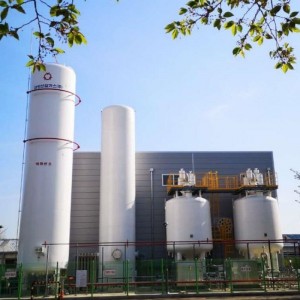- Typical feed: Methanol
- Capacity range: 10~50000Nm3/h
- H2 purity: Typically 99.999% by vol. (optional 99.9999% by vol.)
- H2 supply pressure: Typically 15 bar (g)
- Operation: Automatic, PLC controlled
- Utilities: For the production of 1,000 Nm³/h H2 from methanol, the following Utilities are required:
- 500 kg/h methanol
- 320 kg/h demineralised water
- 110 kW electric power
- 21T/h cooling water
After hydrogen (H2) mixed gas enters the pressure swing adsorption (PSA) unit, various impurities in the feed gas are selectively adsorbed in the bed by various adsorbents in the adsorption tower, and the non-adsorbable component, hydrogen, is exported from the outlet of the adsorption tower. After the adsorption is saturated, the impurities are desorbed and the adsorbent is regenerated.
PSA Hydrogen Plant Applicable Feed Gas
Methanol cracking gas, ammonia cracking gas, methanol tail gas and formaldehyde tail gas
Synthetic gas, shift gas, refining gas, hydrocarbon steam reforming gas, fermentation gas, polycrystalline silicon tail gas
Semi-water gas, city gas, coke oven gas and orchid tail gas
Refinery FCC dry gas and refinery reforming tail gas
Other Gas Sources Containing H2
PSA Hydrogen Plant Features
The TCWY PSA hydrogen purification plant boasts a range of impressive features that make it a top choice for hydrogen production in various industrial settings. It stands out by customizing its process route to align precisely with the specific needs of each factory, ensuring not only high gas yield but also consistently stable product quality.
One of its core strengths lies in its utilization of highly efficient adsorbents that exhibit exceptional selectivity for impurities, thereby guaranteeing a reliable and enduring performance with a lifespan exceeding 10 years. Moreover, this plant incorporates special programmable control valves designed for extended longevity, with a lifespan also exceeding a decade. These valves can be tailored to operate using either oil pressure or pneumatic mechanisms, enhancing flexibility and adaptability.
TCWY PSA Hydrogen Plant features a flawless control system that harmonizes seamlessly with various control configurations, making it a versatile and reliable solution for diverse industrial needs. Whether it's the robust performance, extended lifespan, or adaptability to various control systems, this hydrogen plant excels on all fronts.
(1) PSA-H2 Plant Adsorption Process
Feed Gas enters adsorption tower from the bottom of the tower (One or several are always in the state of adsorbing). Through the selective adsorption of various adsorbents one after one, the impurities are adsorbed and un-adsorbed H2 flow out from the top of the tower.
When the forward position of mass transfer zone (adsorption forward position) of the adsorption impurity reaches the exit reserved section of the bed layer, turn off the feed valve of the feed gas and the outlet valve of product gas, stop adsorption. And then the adsorbent bed is switched to regeneration process.
(2) PSA-H2 Plant Equal Depressurization
After the adsorption process, along the direction of adsorption put higher-pressure H2 at adsorption tower into other lower pressure adsorption tower which has finished regeneration. The whole process is not only depressurization process, but also the process for recovering H2 of bed dead space. The process includes several times on-stream equal depressurization, so H2 recovery can be fully ensured.
(3) PSA-H2 Plant Pathwise Pressure Release
After equal depressurization process, along the direction of adsorption the product H2 on top of the adsorption tower is quickly recovered into the pathwise pressure release gas buffer tank (PP Gas Buffer Tank), this part of H2 will be used as regeneration gas source of adsorbent depressurization.
(4) PSA-H2 Plant Reverse Depressurization
After pathwise pressure release process, the adsorption forward position has reached the exit of bed layer. At this time, the pressure of adsorption tower is reduced to 0.03 barg or so at the adverse direction of adsorption, large amount of the adsorbed impurities begin to be desorbed from the adsorbent. The reverse depressurization desorbed gas enters the tail gas buffer tank and mix with the purging regeneration gas.
(5) PSA-H2 Plant Purging
After reverse depressurization process, in order to gain the complete regeneration of adsorbent, use the hydrogen of pathwise pressure release gas buffer tank at the adverse direction of adsorption to wash the adsorption bed layer, further decrease the fractional pressure, and the adsorbent can be completely regenerated, this process should be slow and stable so that the good effect of regeneration can be ensured. Purging regeneration gas also enter blowdown tail gas buffer tank. Then it will be sent out of the battery limit and be used as fuel gas.
(6) PSA-H2 Plant Equal Repressurization
After purging regeneration process, use higher-pressure H2 from the other adsorption tower to repressurize the adsorption tower in turn, this process corresponds with the equal-depressurization process, it is not only a process of pressure boosting, but also a process of recovering H2 in the bed dead space of other adsorption tower. The process includes several times on-stream equal-repressure processes.
(7) PSA-H2 Plant Product Gas Final Repressurization
After several times equal repressurization processes, in order to switch the adsorption tower to next adsorption step steadily and to ensure the product purity not to be fluctuated, it needs to use product H2 by boost control valve to raise the pressure of adsorption tower to adsorption pressure slowly and steadily.
After the process, the adsorption towers complete an entire “adsorption-regeneration” cycle, and makes preparation for next adsorption.




















